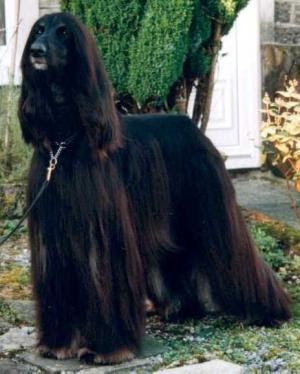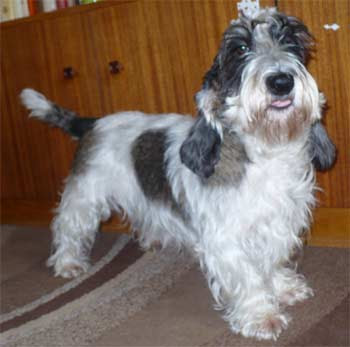Scottish Deerhound Information and Pictures
Description: Being somewhat reminiscent of a shaggy looking greyhound, the Scottish deerhound is a tall dog, with muscular upper legs. The coat is much longer than that of greyhounds, being some 3-4 inches in length and can be a variety of colours including black, grey, blue black etc. and can sometimes have white on its tail, feet, or chest. Standing between 28-32 inches in height they are a very tall dog for their weight, which is between 75 and 110 pounds. They've a long tail which they carry low and almost touches the ground.
History. It is as you would guess by its appearance a fairly close relative greyhound; it was specifically bred for its long coat, to protect it from the adverse weather. And the long powerful legs to give it a good turn of speed when hunting the deer, for which it was bred. It is also believed that these dogs were used during the middle Ages by some of the Scottish tribes, making it a very old breed indeed. They gained popularity with the hierarchy and became known as the Royal dogs, when legislation was passed making it so that nobody below and Earl could own one. Queen Victoria herself had a Scottish deerhound as did Sir Walter Scott. However, the breed became endangered as a result of the ruling. Because there were not so many people actually allowed to own this breed, the breeders were hardly endeared to the continued breeding of a dog which nobody could buy. However, after this ruling was repealed breeding commenced again and the deerhound was saved.
Temperament. Scottish deerhounds are generally well mannered and gentle dogs. They are a friendly, polite, with an exceptionally loving nature, and can prove to be extremely good with children. They are loyal and devoted to their owners,but they are unsuitable as guard dogs or watchdogs, as they tend to just like everybody. As they are a form of hunting dog training tends to be easier, but you must assert yourself in a strong but friendly fashion or the dog may believe themselves to be in charge and problems will occur. They can get on well with other dogs, but are unsuitable if you have any pets other than dogs. They can become destructive if bored, so adequate exercise is essential.
Health issues. The serious health risks with this breed include cardiomyopathy, osteosarcoma, and gastric torsion with a predisposition to bloat, it is a good idea to feed your dog less food at a time and more often, feed, small meals, two to three times, a day rather than one big meal. And they generally live around 10 years.
Grooming. Quite extensive and regular grooming is required for this breed, they also require stripping and some trimming of the hair, but, unless you are showing your dog, you can probably achieve this yourself. You'll need a good firm brush and comb and obviously a pair of scissors for trimming. If you are planning to show the dog then it would be necessary that the trimming to be done at a salon, unless you are sufficiently experienced.
Living conditions. They do best living in a house with a large yard, preferably fenced. However, if adequately exercised, they will be fairly inactive indoors and, can adapt to living in an apartment. They are excellent with families and love to play with children, obviously when playing with small children supervision is necessary, as they are such a large dog, there is always the risk of accidental injury.
For more information on different Dog Breeds, Dog Training and Teacup Puppies for sale including Yorkies, Chihuahuas and Morkies please visit our websites below.
Article Source: http://EzineArticles.com/?expert=Scott_Allan_Lipe
Black and Tan Coonhound Information
The Black and Tan Coonhound is a friendly dog that was bred in the United States to tree raccoons and scent hunt other animals. They prefer to stay outdoors and can tolerate heat and cold. They need lots of exercise and it is best to have them on a farm or to have plenty of properly fenced in area for them to run in. They are good watch dogs and generally work well with other dogs. They need to be brushed occasionally but do need regular ear maintenance. They have low trainability so they are generally not trained for other tasks besides the hunt. They are good with older children but may not tolerate younger ones. Just a reminder, never leave children of any age unsupervised with a puppy or dog for any length of time.
Approximate Adult Size
The approximate adult size (two years old or older) of the male Black And Tan Coonhound is 25 to 27 inches to the withers (highest point of the shoulder) and the females range from 23 to 25 inches to the withers. They weigh from 50 to 75 pounds with the males being heavier.
Special Health Considerations
Most dog breeds have certain inherited health problems associated with that specific breed and the Black And Tan Coonhound is no exception. The following can be a problem. Canine hip dysplasia (genetic based looseness in the hip joint that can lead to arthritis pain and lameness), Ear Canker (lack of air circulation, wax, dirt and moisture can lead to an ear infection characterized by dark discharge and foul odor), Progressive Retinal Atrophy (inherited disease of the retina that can cause vision loss and blindness) and a blood disorder Hemophilia B.
This disease list is an informative guideline only. Other diseases may also be significant threats, please contact your veterinarian if you think that your puppy or dog has a problem and for a complete list of breed specific diseases.
She should visit the veterinarian several times in the first year for shots, boosters and check up. Then, as an adult, she should visit the veterinarian yearly for shots and check up. As she gets older, six years and on, she should visit the veterinarian twice a year for check ups and shots. Also, avoid feeding your puppy or dog sweets.
Grooming
The Black And Tan Coonhound has a short, glossy coat that needs occasional brushing. Brushing will help her maintain a clean and healthy coat and also help you keep a closer eye on her health and strengthen your emotional bond with your pet. Additionally her ears need regular attention to help keep her from catching ear canker, an infection caused by damp, dirty ears that do not get enough air, a problem with breeds with pendulous ears.
Her teeth should be brushed at least twice a week with toothpaste and toothbrush designed for dogs. Brushing removes the accumulation of plaque and tartar which can cause cavities (rarely) and periodontal disease. Dog periodontal disease can lead to pain, loss of teeth, bad breath and other serious disease.
Her toenails may need to be examined for growth and clipped regularly. The toenails of the rear feet grow slower than the toenails of the front feet. Generally a guillotine type trimmer is the best for this chore and competent instructions to accomplish this can be found on the net.
Life Span
The Black And Tan Coonhound can live between 10 and 12 years with proper nutrition, medical care and excellent living conditions.
History
Hails all the way back to extinct hounds in the eleventh century plus Bloodhound, the American Foxhound and the English Foxhound. Mountain people of the United States from Virginia, The Great Smoky Mountains and the Ozarks developed the breed to tree raccoons and hunt game in general. The American Kennel Club first registered them in 1945.
Some Registries
- American Black and Tan Coonhound Club
- UKC United Kennel Club
- NKC National Kennel Club
- CKC Continental Kennel Club
- APRI Americas Pet Registry Inc.
- AKC American Kennel Club
- FCI Federation Cynologique Internationale
- ACR American Canine Registry
Litter Size
7 to 8 Black And Tan Coonhound puppies
Category
Hound
Terms To Describe
Hunter, lively, loyal, intelligent, courage, outgoing, friendly, even tempered, very active.
SPECIAL GOOD POINTS
- Loves to hunt.
- Good watch dog.
- Can handle cold and heat.
SPECIAL BAD POINTS
- Low obedience.
- Mediocre guard dog.
- May wander off after a scent.
- Low trainability.
Other Names Known By
American Black and Tan Coonhound, Treeing Hound
Every dog is an individual so not everything in this information may be correct for your dog. This information is meant as a good faith guideline only.
Mitch Endick is a short article writer for the popular pet site: http://www.petpages.com He provides informative advice on all pets including dogs, puppies, cats, fish, reptiles, birds, ferrets, rabbits, mice and even pet bugs. Petpages.com also has an extensive pet classified ads section.
Article Source: http://EzineArticles.com/?expert=Mitch_Endick
Petit Basset Griffon Vendéen
Greyhound Large Dog Breeds
Ibizan Hound Pictures
 Ibizan Hound Pictures
Ibizan Hound Pictures






















